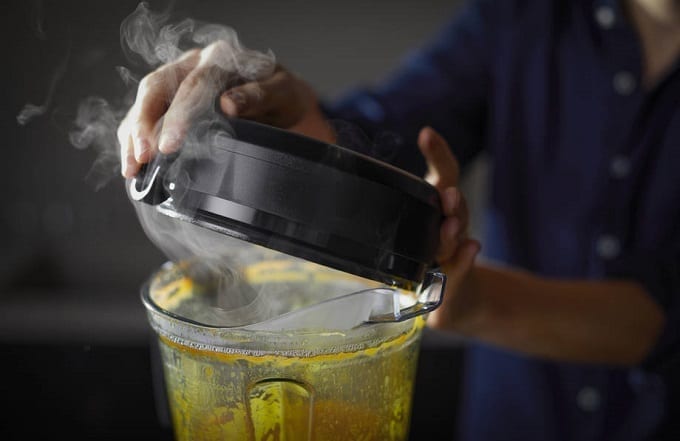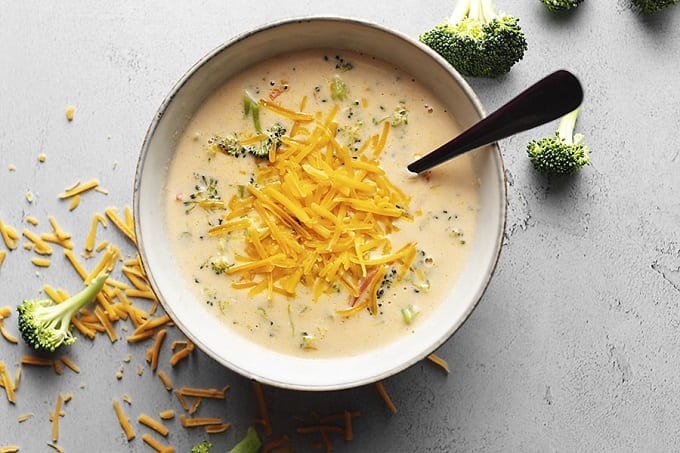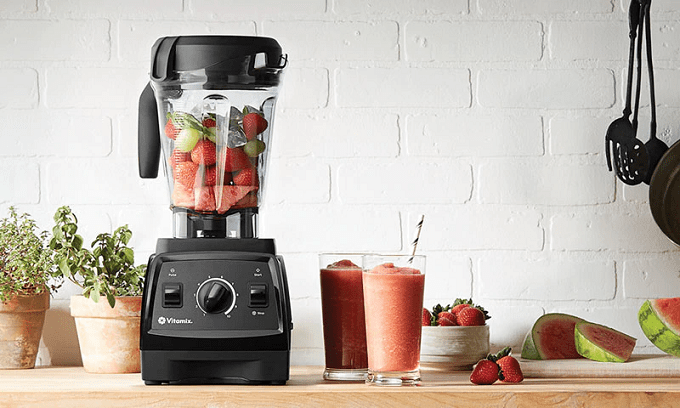The stove’s all full-up, or you just don’t feel like cleaning out the big stockpot (don’t worry, we’re with you on that one).
You want to prepare hot food in the blender, or at least transfer it into the blender to complete the process, but can you do it?
The short answer is yes, you can, but it comes with stipulations and understanding what your blender can handle.
For instance, glass pitchers can handle more than plastic, and the power of your motor is also going to determine just how much it can handle.
If your blender can crush ice, then it can also handle hot foods.
There’s a seemingly endless collection of possibilities regarding what recipes you can finish or entirely conjure in your blender, so we’ve added some recipes at the end of this article to give you a jumpstart.
How Hot is Too Hot for Blenders?

It depends on what the hardware is.
For example, are you using a plastic pitcher or a glass one? Glass is better for hot food since glass can’t leach chemicals like BPA into your food or drink.
While BPA is widely not included in most plastic manufacturing over the last ten years, that’s just because of major widespread public media coverage.
It’s not even the most harmful ingredient in plastic.
Plastics can leach into your food when it’s heated up, and since blenders are usually meant for smoothies or room temperature cooking, it’s not unreasonable to assume that plastic is getting into your food.
That being said, it also depends on the blades and how well they can handle the heat. Pouring hot food into a pitcher, which has stainless steel blades on the bottom, isn’t going to tarnish the blades.
They’re built strong and likely forged at temperatures more than eight times the heat of boiling water. However, the plastic that houses the blades could be affected.
As a rule of thumb, you shouldn’t put anything boiling into your blender pitcher. Temperatures of around 190° F are acceptable.
What Type of Hot Food Can You Prepare in a Blender?
We’ve got some recipes for you to try out, which should tell you a bit about what your blender can handle.
Truth be told, you can blend just about any hot food in your blender, it’s just best to avoid boiling liquids of any variety.
Not only can it try to leach away chemicals out of the plastic, but it could slightly scald the food and give it a less than desirable taste.
The main food types that you should be making in your blender are those with a higher liquid concentration, like soups or sauces.
You can make a mean alfredo sauce with the help of a high powered motor and some stainless steel blades, among other things. Take a look for yourself.
How to Prepare the Pitcher Cup?
You don’t have to do much to prepare your pitcher.
If you were making frozen desserts, we would recommend chilling it in the freezer for ten to twenty minutes beforehand, but it wouldn’t make much sense to heat up a pitcher that’s going to have hot food in it anyway.
The worst is that it can get cold, whereas, with frozen desserts, it would melt and ruin the dish. If you’re using a glass pitcher, just don’t take it from one extreme to the other.
You’ll notice that glass pitchers are especially thick compared to plastic ones, and that’s a good thing for durability and safety, but it can have a downside.
If the pitcher were being kept in a pantry in the middle of winter, and it was cold, you can’t just drop near-boiling soup into the thing.
Glass expands and contracts, and while it can do it remarkably well, the thicker the glass, the more time it takes to expand and retract properly.
These changes are small enough that we don’t really notice any swelling of the glass, but they are present.
To avoid any problems, you could opt for a heat resistant pitcher from the manufacturer of the model you’re selecting. BlendTec and Vitamix tend to have good heat resistance on their glass pitchers.
While glass is arguably better, plastic doesn’t have to expand and contract like this (and has no risk of cracking or shattering from temperature changes), so it’s become more common to use a plastic pitcher than glass.
They’re also wildly inexpensive in comparison.
You can side with whatever you feel will work best. In our opinion, even though they’re heavier and sometimes bulkier to clean, the glass will always be more viable than plastic.
When you learn about how plastic and polymers change over time and leach chemicals into your food, it has you rethinking a lot of things.
Quick Hot Blender Recipes
Broccoli Cheese Soup

Broccoli and cheese soup is a lifelong favorite of so many people (me included), and it’s dead simple to make in a blender.
Using fresh broccoli, milk, chicken broth, sharp cheddar, parmesan, and garlic, you can whip up a fantastic soup. Use yellow onion thrown into the mix, as well as ground pepper and salt to taste.
Add some thickly shredded cheddar cheese on top at the end and oyster crackers for garnish, and it’ll be one of the best things you’ve ever eaten.
Pizza Sauce
A fan of making homemade pizza?
You can whip up some hot pizza sauce in the pitcher and blend it into perfection, making it as authentic and chunky as you’d like, or blending it into a fine puree to keep things nice and smooth.
Tomato, basil, oregano, and some water depending on how thin or thick you like it, and you’ll be in heaven.
Cheese Sauce
Homemade macaroni and cheese is comfort food and a fan favorite of children everywhere, and that’s because it’s lightyears better than anything that could come out of a blue box.
With milk, cheddar, flour and a touch of salt and pepper will make a fantastic cheddar cheese sauce to the top just about anything with.
If you’re making homemade cheese fries, this is basically the perfect match, no matter what type of potato you use.
Crab Cakes
Freshly cooked crab (or lobster, if you’re daring) can be thrown right into the blender, as well as your eggs, olive oil, green onions, cubed bread, and spices.
Crab cakes should be pan-fried after you’ve prepared them in your blender, but at the very least, your blender will help to keep all of the ingredients hot in the meantime.
If you’re doing anything with seafood and you’re mixing it into another dish, blend it up first, and it’ll go a long way.
Risotto
Haven’t had risotto lately?
That’s because it can be a pain in the neck to make, but your blender will help you out a bit. Mix in your broth, onions, parmesan, spinach, and your cooked arborio rice.
It takes most of the guesswork out of making this dish and evenly distributes flavor and texture throughout the entire dish, os you won’t be left with pockets that sorely lack seasoning, or don’t have enough of whatever vegetables you decide to add-in.
What’s the Best Blender for Blending Hot Food?

The Vitamix 750 professional model is among the best blenders in the world for preparing hot food.
It’s not just about tossing hot ingredients into the pitcher and calling it a day; the 750 offers a soup mode, which can take your normal room temperature ingredients that haven’t been put into a pot on the stove, and heat them up through friction from the stainless steel blades.
Yes, those 72° F carrots that were on the counter can be steaming and completely imbued into your soup in under ten minutes.
It’s one of the functions that make Vitamix the more versatile blender option.
There’s also a 12 amp motor with aircraft-grade stainless steel blades, which helps to pulverize whatever you throw inside, provided that you select the right setting.
Speaking of settings, there are five pre-programmed options on the 750 model to make a variety of different foods, with different speeds and power.
Use these to go a bit gentler on heartier meals, like stews and marinara sauces that should have a bit of texture to them. Nothing beats the 750 series.
Get Blending
You can make hot food in a blender, just be careful of plastic, and be sure to maintain your blades.
If you go with a Vitamix model, you can use the soup setting to turn room temperature ingredients into steaming hot food without needing the use of a stove.
Now that you know what your blender can really do, what’s stopping you from making every recipe on this list? Nothing. That’s what.
Subscribe To Stumpf Studio Newsletter
By entering your email address you agree to get email updates from Stumpf Studio. We'll respect your privacy and unsubscribe at any time.
